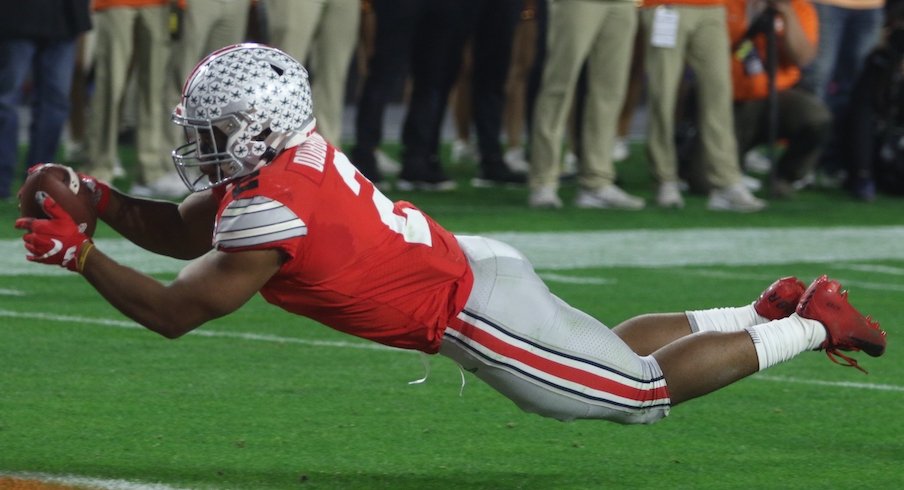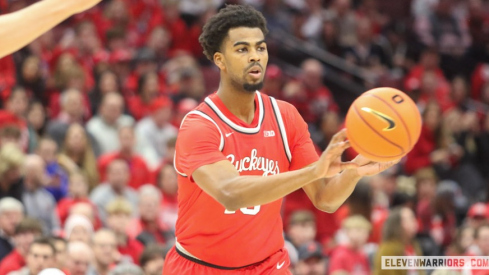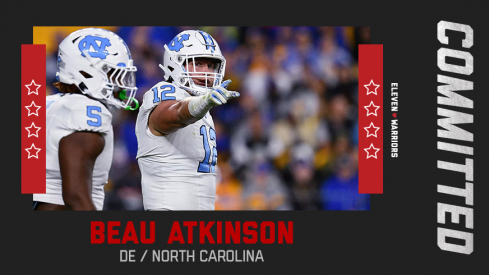Ohio State won't soon get over what happened on Saturday.
A combination of self-inflicted errors and poor execution on certain key plays, along with two massive calls that went Clemson's way, combined to doom the Buckeyes in the Fiesta Bowl, ending what had been a magical 2019 season sooner than they imagined. They fell, 29-23, to the Tigers.
The sudden loss left both those inside and outside the Ohio State football program to wonder what if certain plays had gone its way. Instead, they'll serve as reminders about what could have been.
Here are the 10 agonizing “what-if” plays that had a chance to swing the Fiesta Bowl in the Buckeyes' favor:
What If... Tanner Muse Didn't Catch J.K. Dobbins
What happened: J.K. Dobbins had already rushed for a 68-yard touchdown when Wyatt Davis, Branden Bowen and a linebacker biting on Justin Fields keeping the ball allowed him to break another massive run. He found a hole, swept back across the field to his left and looked like he might score again before Tanner Musa dove and swiped his ankles, ending his run at the 8-yard line.
How it affected the game: Dobbins' scamper likely should have been enough for the Buckeyes to score a second touchdown on Saturday, but as it turns out, it wasn't. Him getting caught from behind meant Ohio State once again found itself in a position where it needed to score from inside the red zone, which didn't happen. The Buckeyes settled for a second of three first-half field goals instead of scoring a touchdown.
What If... J.K. Dobbins Caught The Touchdown Pass
What happened: A beautiful play design on 3rd-and-goal allowed Dobbins to find himself open on a swing route out of the backfield. Justin Fields delivered an on-target pass, and Dobbins appeared to reel it in for the score. A review, though, reversed the call and led to this being deem an incompletion.
How it affected the game: For an offense that converted touchdowns on 78.7 percent of its red-zone opportunities this season, the fourth-best mark in the nation, Ohio State struggled mightily to get the ball into the end zone on Saturday. The pass to Dobbins could have given the Buckeyes a 17-point lead. Instead, due to the drop, they settled for their second of three first-half field goals to give themselves a 13-point advantage. Ohio State never led Clemson by more than 16 points after getting the chance to go up by 17 early in the second quarter.
What If... J.K. Dobbins Caught The Screen Pass
What happened: Dobbins' second drop in the first half also could have led to a touchdown. Clemson's entire defense didn't see the screen pass coming to Dobbins, who had three offensive linemen ahead of him down the field and no opponent within 10 yards. What looked like a possible touchdown, though, turned into one of Fields' 16 incompletions due to a poorly timed drop.
How it affected the game: Another red-zone opportunity, another possible touchdown, another missed opportunity leading to a field goal. Given the green grass ahead of Dobbins and Jonah Jackson, Josh Myers and Wyatt Davis down the field, it's not too difficult to imagine that this could have been a touchdown that gave Ohio State a 20-0 lead. Instead, the drop led to a 3rd-and-long situation that wasn't converted and a third field goal of the first half that increased the edge to 16 points. This was the largest lead for either team of the game, but it could have been larger.
What If... Shaun Wade Wasn't Called For Targeting And Ejected
What happened: Coming off the edge on a blitz, Shaun Wade sacked Trevor Lawrence on third down, appearing to end Clemson's drive and force a punt. However, the referees called Wade for targeting and confirmed the call, which both allowed the Tigers to continue their drive and prematurely ended the cornerback's game.
How it affected the game: Singular, non-scoring plays rarely swing games the way this did. The momentum inside State Farm Stadium swung drastically with Wade's hit and subsequent penalty. Instead of punting and giving the ball back to Ohio State, which had scored points on four of its first five drives, Clemson was able to continue the drive, and five plays later it scored its first touchdown. The following drive, the Tigers scored again, pulling within two points by halftime. Also due to the targeting penalty, Wade was ejected, leaving the Buckeyes without one of their first-round talents at cornerback for the remainder of the game.
What If... Travis Etienne Didn't Convert The First Down
What happened: Lawrence pitched the ball to Travis Etienne on 3rd-and-2 from inside the 10-yard line. Initially, the running back looked as though he wouldn't even make it back to the line of scrimmage. Somehow, though, he avoided tackles from Jordan Fuller, Tyler Friday and Malik Harrison to both convert the first down and score Clemson's first points of the game.
How it affected the game: On a somewhat forgotten play, Clemson's first touchdown almost never happened. Had Fuller or some other Ohio State player wrestled Etienne to the ground before he got to the 6-yard line, the Tigers likely would have settled for a field goal. The comeback would have notably slowed had Etienne not converted the first down. Instead, his touchdown finished off the drive that had continued due to Wade's targeting penalty.
What If... Josh Proctor Tackled Trevor Lawrence
What happened: On an up-the-middle draw, Lawrence found a wide hole through which to take off. Because Jeff Hafley went with two safeties and had Jordan Fuller covering a slot wide receiver, only Josh Proctor stood between him and the end zone. The sophomore safety couldn't get Lawrence to the ground, allowing the quarterback to run for a 67-yard touchdown just before the end of the first half.
How it affected the game: A couple months ago, Hafley called Fuller the "eraser" due to his ability to make tackles in these situations. Proctor's inability to either tackle Lawrence or even at least slow him down allowed Clemson to climb all the way back to within two points by the end of the first half. Had Proctor got him to the ground, the Tigers might not have scored a touchdown on a drive that, before the 67-yard run, was at their own 33-yard line with 1:22 remaining before halftime.
What If... Cameron Brown Wasn't Called For Roughing The Punter
What happened: Ryan Day and Matt Barnes called for a punt block, which nearly worked. But as both Cameron Brown and Chris Olave dove to get their hands on the ball, it sailed past them. Brown ran into the punter's leg and was called for a 15-yard roughing the kicker penalty that extended the drive.
How it affected the game: Rather than getting the ball back with a punt return at their own 44-yard line, Ohio State had to run its defense back onto the field and subsequently gave up a go-ahead 53-yard Lawrence-to-Etienne touchdown pass two plays later. That score to give Clemson the lead simply wouldn't have happened had Brown not ran into the punter.
What If... The Catch, Fumble And Touchdown Return Wasn't Reversed
What happened: In easily the most discussed play after the game, replay review officials took six points off the scoreboard for Ohio State. Justyn Ross initially appeared to catch an 11-yard pass from Lawrence. Jeff Okudah knocked the ball out of his hands and Jordan Fuller scooped it up, racing 29 yards for a touchdown. After a review, though, officials deemed that Ross never had possession, calling the play an incompletion and negating the Ohio State touchdown. After the game, athletic director Gene Smith told Pete Thamel of Yahoo Sports that he was "pissed," and Big Ten supervisor of officials Bill Carollo and national officiating supervisor Rogers Redding said the play should not have been overturned.
How it affected the game: In a quarter with the Buckeyes' offense unable to put any steady drives together, Fuller's scoop-and-score could've given them a jolt. Instead, the reversal took the six points off the scoreboard that would have allowed Ohio State to take a two-point lead in the third quarter.
What If... Ohio State Recovered The Ball That Hit Clemson's Player
What happened: Drue Chrisman's final punt of the evening pinned Clemson inside the 10-yard line, and it almost led to an even more favorable outcome for Ohio State. The ball unexpectedly hit Derion Kendrick, who was blocking Olave, one of the Buckeyes' gunners. The ball only took a small bounce, though, allowing Kendrick to pounce on it.
How it affected the game: It didn't. But with a larger bounce, it could have. Had Ohio State somehow recovered the loose ball, it would have found itself in position to score a touchdown and take a multi-score lead.
What If... Chris Olave Didn't Break Off His Route
What happened: Fields threw a game-sealing interception with 37 seconds remaining when Olave thought his quarterback was about to scramble and broke off his route. The pick ended all Ohio State's hopes of a comeback. After the game, Olave took full responsibility for the miscommunication.
How it affected the game: It ended the game. Had Olave continued his route, there's a chance he would've snagged a game-winning touchdown. But no one will ever know.


